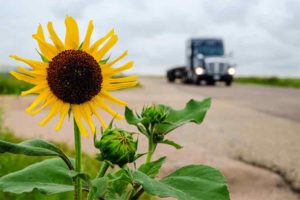Commercial vehicle manufacturers grasped the opportunity and now they invest heavily in offering the next autonomous vehicles, with many social benefits to follow such as less fuel consumption, reduction in CO2 emissions, less congestion, fewer accidents, injuries and deaths.
 However, autonomous road vehicles are still under development and all efforts to use alternative fuels such as biodiesel, bioethanol, hydrogen, natural gas or liquid petroleum are still in their infancy and in turn, have their own environmental impacts (e.g. the land used for planting crops for biodiesel could be used better for planting food). Using these types of alternative fuel strategies to replace carbon-based fuels is not so straightforward and are limited to niche sectors, such as city logistics.
However, autonomous road vehicles are still under development and all efforts to use alternative fuels such as biodiesel, bioethanol, hydrogen, natural gas or liquid petroleum are still in their infancy and in turn, have their own environmental impacts (e.g. the land used for planting crops for biodiesel could be used better for planting food). Using these types of alternative fuel strategies to replace carbon-based fuels is not so straightforward and are limited to niche sectors, such as city logistics.
The “Europe 2020” strategy
The EU has set ambitious climate and energy targets for their Europe 2020 strategy as sustainability remains a major concern for the European government.
By establishing their 2020 agenda, the EU wants to achieve the following:
- 20% reduction in greenhouse gas emissions on 1990 levels
- 20% of energy use from renewable resources
- 20% improvement in energy efficiency
The European Environmental Agency states that road transport emits considerably more CO2 per km than other models. For instance, road freight accounts for approx. 8% of total CO2 emissions worldwide. As the transport demand is closely linked to recent economic activity, in periods of growth the economic output goes up, more goods are transported and as a result, more people travel. The EU’s overall transport emissions in 2014 were 20% higher than their 1990 levels.
To sum up, the achievement of their targets is not endangered by the growing logistics industry itself but by not reshaping environmental policies and encouraging businesses to innovate in difficult times of transition.
Quellen:
European Environment Agency (2016), Transport in Europe: key facts and trends, 06.12.2016, https://www.eea.europa.eu/signals/signals-2016/articles/transport-in-europe-key-facts-trends.
PBL Netherlands Environmental Assessment Agency (2016), Trends In Global CO2 Emissions: 2016 Report, PBL publication number: 2315, The Hague, 2016.
EU Commission (2017), Europe 2020 Strategy, https://ec.europa.eu/info/strategy/european-semester/framework/europe-2020-strategy_en, retrieved 20.07.2017.
Ti (2016), European Road Freight Transport 2016, Transport Intelligence Ltd: Bath (UK). https://www.prnewswire.com/news-releases/european-road-freight-transport-2016-300390398.html
See Eurostat (2017), Freight transport statistics, data extracted April 2017.
INRIX (2017), Global Traffic Scorecard 2016.









